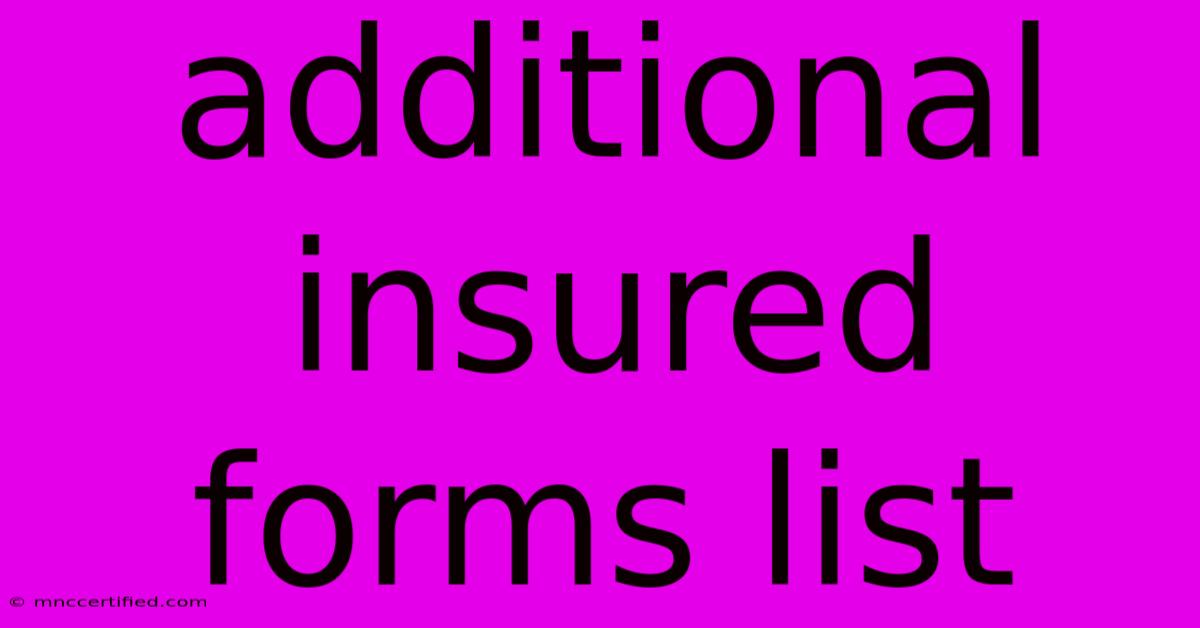Additional Insured Forms List

Table of Contents
Understanding and Utilizing Additional Insured Forms: A Comprehensive List and Guide
Adding an additional insured to your insurance policy is a crucial step in risk management, particularly for businesses and contractors. This article provides a comprehensive guide to understanding additional insured forms, their importance, and a list of common forms used across various industries. We'll also explore best practices to ensure you're adequately protected.
What is an Additional Insured?
An additional insured is an individual or entity added to an existing insurance policy who isn't directly named as the policyholder but gains protection under the policy's coverage. This protection typically extends to liability claims arising from the additional insured's operations related to the policyholder. Think of it as an extra layer of protection for both parties involved.
Why are Additional Insured Forms Important?
These forms are essential for several reasons:
- Contractual Requirements: Many contracts, especially those in construction, require contractors or subcontractors to add the client (or general contractor) as an additional insured on their liability insurance. This protects the client from potential lawsuits stemming from the contractor's work.
- Risk Mitigation: Adding an additional insured helps mitigate risk by ensuring that both parties are financially protected in the event of an accident or incident.
- Legal Protection: Having an additional insured designation provides crucial legal protection, preventing disputes and potential financial burdens in case of liability claims.
- Business Relationships: It strengthens business relationships by demonstrating a commitment to shared responsibility and risk management.
Common Scenarios Requiring Additional Insured Coverage:
- Construction Projects: General contractors often require subcontractors to name them as additional insureds.
- Leasing Agreements: Property owners might require tenants to add them as additional insureds on their liability policies.
- Independent Contractors: Businesses hiring independent contractors may request additional insured coverage to protect themselves from potential liabilities.
List of Common Additional Insured Forms
While specific forms can vary by insurance company, here's a list of commonly used types:
- ACORD 25: This is a widely recognized form used to add additional insureds. It's a standardized form, ensuring clarity and consistency. Understanding the nuances of this form is vital for accurate coverage.
- ISO CG 20 10: This form is often used in the construction industry, specifying the scope of coverage for additional insureds.
- Other Customized Forms: Insurance companies may use their own proprietary forms. Always review the specific wording carefully to understand the scope of coverage.
Key Considerations When Reviewing Additional Insured Forms:
- Scope of Coverage: Carefully examine the wording to understand precisely what risks are covered for the additional insured. Look for terms like "occurrence," "completed operations," and "cross liability."
- Primary vs. Excess Coverage: Determine whether the additional insured coverage is primary (meaning it will pay first) or excess (meaning it only pays after the primary policy is exhausted).
- Notice of Cancellation: Ensure the form specifies that the additional insured will receive notice of cancellation or changes to the policy. This is critical for ongoing protection.
Best Practices for Using Additional Insured Forms
- Review with Your Insurance Agent: Consult with your insurance agent to ensure you're using the appropriate form and understand the coverage implications.
- Clear Communication: Communicate clearly with all parties involved to ensure everyone understands the terms and conditions of the additional insured status.
- Regular Review: Review your policies and forms periodically to ensure they are still appropriate for your needs and comply with any contractual obligations.
Conclusion
Additional insured forms are a fundamental aspect of effective risk management. Understanding the various forms, their implications, and best practices is essential for protecting your business and maintaining strong working relationships. By following this guide and working closely with your insurance provider, you can ensure you have the appropriate coverage in place. Don't hesitate to seek professional advice to ensure your specific needs are met. Remember to always review your contracts carefully and understand the implications of any additional insured requirements.

Thank you for visiting our website wich cover about Additional Insured Forms List. We hope the information provided has been useful to you. Feel free to contact us if you have any questions or need further assistance. See you next time and dont miss to bookmark.
Featured Posts
-
Cowboys Qb Cooper Rush Thanksgiving Game
Nov 29, 2024
-
Gap Insurance For Motorcycles
Nov 29, 2024
-
Steve Miller Insurance Agency
Nov 29, 2024
-
Rangers Players Rated Europa League Victory
Nov 29, 2024
-
Bobby Brock Insurance Reviews
Nov 29, 2024